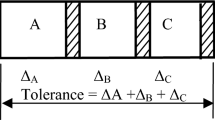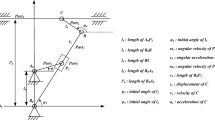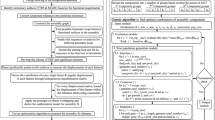Abstract
The demands on assembly accuracy require accurate operations both in machining and assembly in order to achieve the high performance of products. Although advanced machining technologies can be used to satisfy most of the demands on precision assembly, the corresponding manufacturing cost will also be increased. Selective assembly provides an effective way for producing high-precision assembly from relatively low-precision components. The accuracy of selective assembly is mainly based on the number of groups and the range of the group (allocated equally on the design tolerance). However, there are often surplus parts in some groups due to the imbalance of mating parts, especially in the cases of undesired dimensional distributions, which makes the methods developed and reported in the literature, often not suitable for practice. In this work, a genetic algorithm is proposed by applying batch selective assembly method to a complex assembly with three mating components (as in ball bearing: an inner race, ball, and outer race), to minimize the surplus parts and thereby maximizing the manufacturing system efficiency.The proposed algorithm is tested with a set of experimental problem datasets and is found outperforming traditional selective assembly and sequential assembly methods, in producing solutions with maximum manufacturing system efficiency.
Similar content being viewed by others
References
Fang XD, Zhang Y (1995) A new algorithm for minimizing the surplus parts in selective assembly. Comput Ind Eng 28:341–350
Chan KC, Linn RJ (1998) A grouping method for selective assembly of parts of dissimilar distributions. Qual Eng 11(2):221–234
Kannan SM, Jayabalan V (2001) A new grouping method for minimizing the surplus parts in selective assembly. Qual Eng 14(1):67–75
Kern DC (2003) Forecasting manufacturing variation using historical process capability data: application for random assembly and serial processing. Dissertation, Massachusetts Institute of Technology, pp 137–188
Chen M-S (1996) Optimising tolerance allocation for mechanical components correlated by selective assembly. Int J Adv Manuf Technol 12:349–355
Mease D, Sudjianto A, Nair VN (2004) Selective assembly in manufacturing: statistical issues and optimal binning strategies. Technometrics 46(2):165–175
Kannan SM, Asha A, Jayabalan V (2005) A new method in selective assembly to minimize clearance variation for a radial assembly using genetic algorithm. Qual Eng 17:595–607
Stoll HW (1999) Product design methods and practices. CRC Press, Boca Raton, USA
Yan Wang Y (2008) Semantic tolerance modelling with generalized intervals. J Mech Des 130(8):10.1115/1.2900715
Chen TL, Chen CC, Huang YC, Lin WJ (2008) Stability and almost disturbance decoupling analysis of nonlinear system subject to feedback linearization and feed forward neural network controller. IEEE Trans Neural Netw 19(7):1220–1230
Chen CW, Yeh K, Liu KFR (2009) Adaptive fuzzy sliding mode control for seismically excited bridges with lead rubber bearing isolation. Int J Uncertain Fuzziness Knowl-Based Syst 17(5):705–727
Chen CY, Lin JW, Lee WI, Chen CW (2010) Fuzzy control for an oceanic structure: a case study in time-delay TLP system. J Vib Control 16:1651–1672
Fujino Y (1987) Matching problem when lot size is large. Rep Stat Appl Res 34:1–10
Shan HS, Satyawadi A (1989) Computer-aided component selection for precision assembling. 10th international conference on production research. University of Nottingham, UK, pp 734–739
Coullard CR, Gamble AB, Jones PC (1998) Matching problems in selective assembly operations. Ann Oper Res 76:95–107
AkachaiJantayavichit (2000) Efficient algorithms for tolerance improvement through selective assembly. Ph.D. thesis, University of Wisconsin-Madison, pp 128–160
Parrish A (1973) Mechanical engineer's reference book. Butterworths, London
Osma A (2009) A statistical approach to comparing whell hub forging processes. Proc Int Mech Eng D J Automobile Eng 223:1559–1576
Lind DA, Marchal WG, Wathen SA (2005) Statistical techniques in business and economics, 12th edn. McGraw-Hill Irwin, New York
Author information
Authors and Affiliations
Corresponding author
Rights and permissions
About this article
Cite this article
Victor Raj, M., Saravana Sankar, S. & Ponnambalam, S.G. Genetic algorithm to optimize manufacturing system efficiency in batch selective assembly. Int J Adv Manuf Technol 57, 795–810 (2011). https://doi.org/10.1007/s00170-011-3326-2
Received:
Accepted:
Published:
Issue Date:
DOI: https://doi.org/10.1007/s00170-011-3326-2




